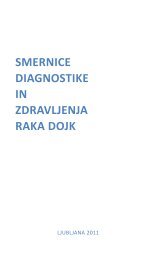Create successful ePaper yourself
Turn your PDF publications into a flip-book with our unique Google optimized e-Paper software.
The influence <strong>of</strong> Mg ions on the efficiency <strong>of</strong> gene electrotransfer<br />
Saša Haberl, Mojca Pavlin, Damijan Miklavčič<br />
Faculty <strong>of</strong> Electrical Engineering, University <strong>of</strong> Ljubljana, Trzaška 25, SI-1000 Ljubljana, Slovenia<br />
Gene electrotransfection is a method, that transfers DNA into living cells using electric<br />
pulses. The process is complex and is composed <strong>of</strong> several steps: binding <strong>of</strong> DNA to<br />
cell membrane, translocation <strong>of</strong> DNA across cell membrane and into the nucleus and<br />
expression <strong>of</strong> DNA.<br />
Binding <strong>of</strong> DNA to the cell surface is the first step <strong>of</strong> the electrotransfection <strong>of</strong> cells.<br />
Since Mg 2+ ions where shown to act as a bridge between negatively charged DNA and cell<br />
membrane and thus increase interaction, we studied the influence <strong>of</strong> Mg 2+ ions on gene<br />
electrotransfer and survival <strong>of</strong> cells in vitro.<br />
Electropermeabilization was performed on 24 hours old Chinese hamster ovary cells grown<br />
as a monolayer culture. Before application <strong>of</strong> pulses we removed culture medium from<br />
cells and incubated them with the plasmid DNA that codes for GFP (green fluorescent<br />
protein) in a specific electroporative buffer, that had different concentrations <strong>of</strong> divalent<br />
cations (2 mM, 4 mM, 6 mM, 8 mM, 10 mM and 50 mM Mg). Trains <strong>of</strong> four rectangular<br />
pulses, duration: 200 μs, repetition frequency: 1 Hz, pulse amplitude: 60 - 280 V were<br />
applied. The distance between a pair <strong>of</strong> two parallel wire stainless steel electrodes was<br />
d = 0.2 cm.<br />
After the pulsing fetal calf serum (FCS) was added (25% <strong>of</strong> sample volume). Treated cells<br />
were incubated for 5 minutes at 37° C to allow cell membrane resealing and then grown for<br />
24h in cell culture medium at 37° C in a humidified 5% CO2 atmosphere in the incubator.<br />
Cell concentration in all media was 5 × 104 cells/ml and plasmid DNA concentration<br />
was 10 μg/ml. Efficiency <strong>of</strong> gene transfection was determined by fluorescent microscopy<br />
(Zeiss 200, Axiovert, Germany).<br />
In general,<br />
p16<br />
electroporation efficiency increased with increasing electric field strength in<br />
all media tested. Our experiments suggest that within the range <strong>of</strong> MgCl 2<br />
use d ( from<br />
mM to 8 mM) the transfection efficiency increased with increasing concentration <strong>of</strong> ions.<br />
But when we used higher concentrations (10 mM and 50 mM) <strong>of</strong> Mg ions the efficiency<br />
<strong>of</strong> gene transfection dropped significantly. The observed drop in gene transfection could<br />
be due to the fact, that divalent cations either bridge negatively charged plasmid DNA to<br />
negatively charged cell membrane with high affinity, or as it was shown in some experiments<br />
divalent ions (mostly Mg 2+ ) increase activity <strong>of</strong> DNAase, which consequently decreases<br />
the transfection rate.<br />
98
















